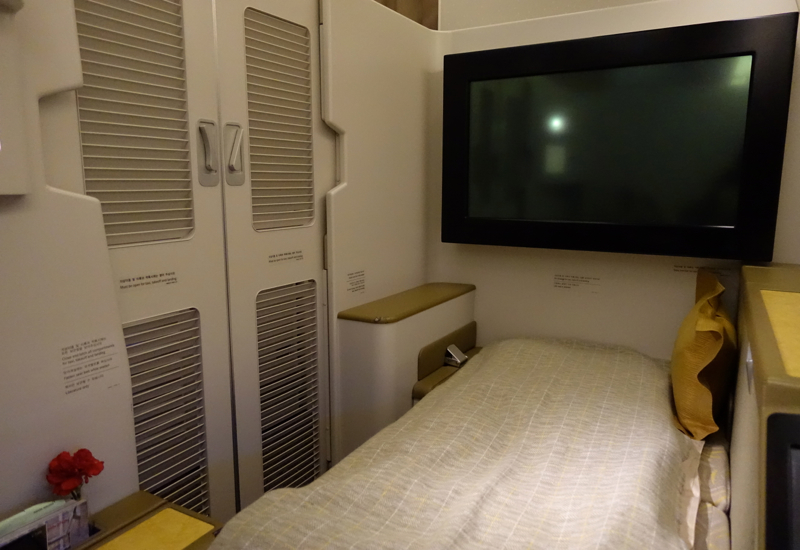Korea Herald carried a piece, “Asiana to remove nearly all its first-class seats” the upshot of which is that Asiana is losing money and plans to keep first class only on its Airbus A380 aircraft.

Asiana Airlines Inc., South Korea’s No. 2 flag carrier, said Wednesday it plans to eliminate almost all its first-class seats from its international flights as part of an effort to cut losses.
…The airline’s loss during the April-June period widened to 85.4 billion won ($71.63 million) from the previous year’s loss of 11.8 billion won, with sales falling to 1.3 trillion won from the previous 1.4 trillion won over the cited period.
“Considering that our company is at an absolutely inferior position in terms of supply of first-class seats, all other flights will change to a two-class system, while the first class will remain on our four Airbus 380 airliners,” Kim Soo-cheon, chief executive officer of Asiana, told employees via a video message.
…Of the company’s 74 airliners, only 20 provide first-class seats, and 12 others are run on a mono-class basis.
That means the end of first class on Boeing 747s and 777s.
New York JFK – Seoul and Los Angeles – Seoul currently receive Airbus A380 service. Assuming the A380s stay on those routes, first class would appear to be safe.
There’s a second Los Angeles – Seoul flight operated by a Boeing 777. Presumably that flight will lose first class. (The second Los Angeles flight used to be two-cabin.)

Frankfurt – Seoul is generally serviced by a Boeing 747-400. The 747s are slated to be phased out anyway. At various times London and Chicago has had first class service.
We’re going to see less first class from Asiana, though I’m pleased they’ll be keeping it on their Airbus A380 aircraft. Whether there’s a future for Asiana first class into the future then, even, is a question market.
Interestingly, their Seoul-based rival Korean Air has first class on a greater percentage of its fleet than most carriers even offering the service on many intra-Asia routes and on most long haul services. That makes for great award space. And the airline has managed to perform better financial than Asiana (though I’m not suggesting any causality).



Well Gary, I think it has to do with Asiana’s lack of business partnership with major companies in Korea for their lackluster financial performance, especially compared to its rival Korean Air. Considering that there is discreet geographical discrimination in Korea (Jeollado vs Gyeungsangdo), this partly explains why major companies (most chaebols can trace their roots to Gyeungsangdo) that provide steady stream of air travel business favor Korean Air over Asiana.
Missing the runway at SFO probably doesn’t help either.
Cutting 1st class to save money. I thought it was the big-bucks seats that subsidized the low-class slobs in the back so they could fly on cheap fares. So are they going to add business class or economy seats?
“I thought it was the big-bucks seats that subsidized the low-class slobs in the back so they could fly on cheap fares.”
Yeah, but you can’t run a real airline across an ocean on F/J. The only route on which that kind of works is LON-NYC, and even there you have a smattering of J-only, mostly the usual blend.
Y makes it so you can run the kind of frequencies that attract premium business. J/F are profitable in the “Yeah, it’s a million dollar glass of lemonade, but I only need to sell one!” sense a lot of the time (which we take advantage of by redeeming award miles in J/F). If you’re Asiana, missing the runway at SFO probably means you’re not doing so well selling lemonade (more than MERS).
I would guess OZ might go to a J/Y+/Y configuration, and pack them in 10 across in Y on their 777s. Increasing overall seat density is probably their motivation in dropping F.
South Korea has 50 million people and not all that many millionaires. As noted, KE has a stranglehold on corporate accounts and thus high yield execs. Hard to see how a country and economy the size of South Korea can support two airlines that pretty much duplicate one another’s routes. The UK, France and Germany each have larger populations, but just one airline each that maintains an F cabin. Competing airlines have settled for J/C as their front cabins. Even the three major US airlines (in a country with almost 7x the population of South Korea) have pared back international F cabins as they upgrade fleets. We all know the reality of F on most airlines…the cabin is filled with elites using upgrades and award tickets. OZ’s F was a nice product, though seats on the 744 and 777 were showing their age.